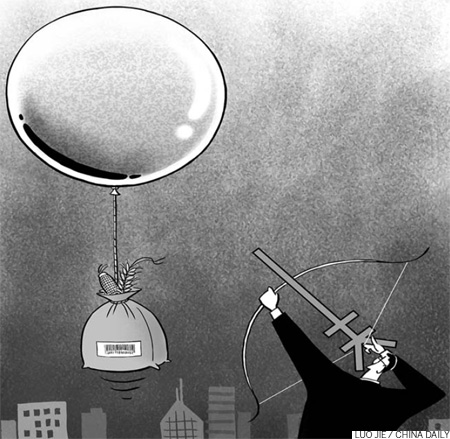Farming alone doesn't drive food prices

International food prices began rising again last summer, and experts - from economists to government ministers - are debating the causes and consequences, and whether it will last long.
International food price trends are certainly important, but not as important as domestic price trends, because international trade does not satisfy most of the food demands around the world. Particularly for large countries like China, which are essentially self-sufficient in basic cereal supplies, domestic price trends will tend to be driven more by domestic macroeconomic policy than by price fluctuations in the world market.
The current rising trend in international food prices is not by itself surprising. The International Food Policy Research Institute recently projected that by 2030 the world price of wheat would be on average 17 percent higher than in 2000, and corn prices would be 33 percent higher. This rise is expected because of increased commercial demand driven by population and income growth, especially in transitional economies such as China.
Today's sudden and surprising international price fluctuations were not widely predicted, however. In 2007 and 2008 international food prices increased sharply. The export price of corn doubled during this period, and the international price of rice tripled. Wheat available for export reached its highest price in 28 years. Global macroeconomic trends were one cause of the increase in 2008, because prices for other commodities - including metals and fuel - were rising at the same time.
Then at the end of 2008 international food prices declined by 40 percent, once again because of forces from outside the farming sector - a Western financial crisis that plunged North America and Europe into recession. In the summer of 2010, however, international food prices began rising again, and by February 2011 they stood 28 percent above the level of a year earlier. Macroeconomic forces were at work again, because international fuel and metals prices were rising as well.
The macroeconomic explanation does not convince everybody. For example, some say it is the low level of food stocks around the world that drives up prices. This was a factor in 2008, but by 2010 those stocks were much higher - up by 40 percent - so this can't be the current explanation. Others blame the booming food demand in China and India for the rise in prices, but when prices first increased in 2008 neither China nor India was a net importer of cereals. Still others say the high prices reflect an exhaustion of modern farming, but US Department of Agriculture's calculations show that productivity growth in farming has been accelerating across the world.
 0
0 






